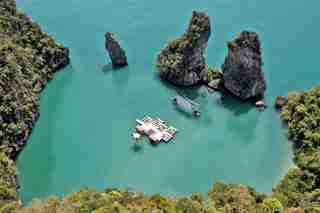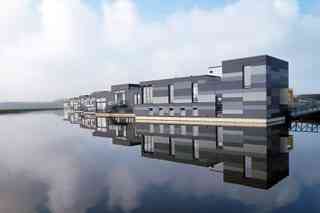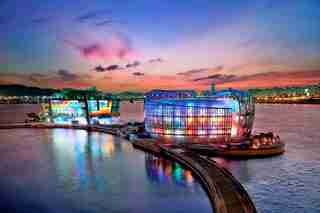Floating Architecture is Making Waves
For some architects, building on land just isn’t enough of a challenge anymore, so they’ve taken their design skills to the water. These astonishing floating structures can be found everywhere from Thailand to Nigeria and contain movie theaters, schools, housing , and offices. Many of the designs include sustainable elements including solar panels and locally-sourced or biodegradable materials.But beyond their environmental benefits, these examples of floating architecture offer a unique way to experience their settings, whether it’s a canal in Amsterdam or a river in South Korea. Browse these beautiful and innovative structures from around the world. After all, with sea levels rising, these designs just might be the wave of the future .

dam-images-architecture-2015-04-floating-arch-floating-architecture-around-the-world-01.jpg
Devised by 2014 AD Innovator Ole Scheeren, the Archipelago Cinema is an outdoor movie theater surrounded by the towering rocks, lush vegetation, and crystal-clear water of Thailand’s Kudu Island. The architect designed the structure in collaboration with the annual Film on the Rocks Yao Noi Festival, which is curated by Thai filmmaker Apichatpong Weerasethakul and British actress Tilda Swinton. Scheeren modeled the structure after the area’s floating lobster farms, using a series of modular platforms to form the main seating section.

dam-images-architecture-2015-04-floating-arch-floating-architecture-around-the-world-02.jpg
This residential community was commissioned by a group of water-loving families in the Netherlands. Drijf in Lelystad, which translates to “Float in Lelystad,” was designed by the Amsterdam-based firm Attika Architekten. Construction took place roughly 25 miles outside of the city, and the completed structures, built on concrete caissons, were towed over water to their destination. In total, eight timber-frame homes—all custom made to fit the requirements of each family—were erected for the project.

dam-images-architecture-2015-04-floating-arch-floating-architecture-around-the-world-03.jpg
Located in Seoul, South Korea, Floating Island was conceived as part of the Han River Renaissance—a municipal campaign to revitalize an often overlooked area of the city. A collaboration between H Architecture in New York and Haeahn Architecture in Seoul, the complex consists of three structures, representing the three stages of a blooming flower: seed, bud, and blossom. Formed from glass, wood, and steel, the islandlike buildings house shops, restaurants, and a number of venue spaces that host festivals, performances, and exhibitions throughout the year.
dam-images-architecture-2015-04-floating-arch-floating-architecture-around-the-world-04.jpg
Hasle Harbour Bath, located on the Danish island of Bornholm, was constructed on the Baltic Sea in an effort to foster tourism in the historic fishing town of Hasle. White, the Scandinavian firm behind the project, set out to design a spot where visitors could take in the incredible water views. Completed in 2013, the bath comprises a floating platform with two bleacherlike seating areas—one nearly 20 feet high—that extend from its base. Guests can relax in the shallow waters contained in the platform’s built-in pool.
dam-images-architecture-2015-04-floating-arch-floating-architecture-around-the-world-05.jpg
Makoko Floating School in Lagos, Nigeria, was conceived by the architecture studio NLÉ as a prototype for buildings that could be moved around coastal regions prone to flooding. Fashioned on a floating base, the three-story school, made from locally sourced bamboo and wood, includes an assembly area, four classrooms, and a workshop. What’s more, the A-frame structure has the capacity to support hundreds of residents in case of emergency.
dam-images-architecture-2015-04-floating-arch-floating-architecture-around-the-world-06.jpg
Arctia Headquarters, the new main office of a Finnish shipping company that owns and operates a fleet of icebreakers, is situated off the shore of Helsinki. Devised by K2S Architects, the structure has a black steel façade that mimics the hulls of the firm’s ships and lacquered-wood interiors that pay tribute to nautical traditions.
dam-images-architecture-2015-04-floating-arch-floating-architecture-around-the-world-07.jpg
The Exbury Egg, named for its location in Hampshire, England’s Beaulieu River (formerly known as the River Exe) and its shape, is a private residence designed by PAD Studio, in collaboration with SPUD Group and artist Stephen Turner. Crafted to have minimal environmental impact, the Egg is powered by photovoltaic panels that provide light and heat.
dam-images-architecture-2015-04-floating-arch-floating-architecture-around-the-world-08.jpg
MOS Architects designed Floating House, a prefabricated home with 1,000 square feet of living space, and erected it off an island in Lake Huron near Ontario, Canada. Supported by steel pontoons, the residence can easily adapt to the lake’s fluctuating water levels, which vary dramatically from season to season.
dam-images-architecture-2015-04-floating-arch-floating-architecture-around-the-world-09.jpg
London’s Camley Street Natural Park was built on top of a deserted coal yard along Regent’s Canal in 1984. Today, the park is a sanctuary for the city’s wildlife and home to Viewpoint Pavilion, a floating platform where visitors can observe nature directly from the canal. Devised by Finnish firm AOR in 2014, the structure was inspired by traditional Scandinavian laavus, primitive shelters that blend into their natural surroundings. The London Wildlife Trust often hosts educational programs at the pavilion.
dam-images-architecture-2015-04-floating-arch-floating-architecture-around-the-world-10.jpg
The Floating Pavilion Rotterdam, seen here on the Netherlands’ Nieuwe Maas River, was designed by DeltaSync and Public Domain Architecten. Made from steel beams and covered with lightweight, translucent ETFE film, the structure serves as a portable exhibition hall and conference space.
dam-images-architecture-2015-04-floating-arch-floating-architecture-around-the-world-11.jpg
The Waterwoningen housing complex is comprised of 75 individual homes. Designed by Marlies Rohmer Architects and Planners, the Amsterdam community can be reached by land or by canal. Below water, each home has a concrete base, providing a lower center of gravity for increased stability. The visible parts of the structure are made from timber with steel-finished plastic moldings. By staggering the houses along the jetties, the firm was able to keep the water a main focal point and provide appealing views from every residence.
dam-images-architecture-2015-04-floating-arch-floating-architecture-around-the-world-12.jpg
When designing an office for a company responsible for cleaning and maintaining Amsterdam’s waterways, Attika Architekten knew sustainability was paramount. Located in the northern part of the old city harbor, the floating office of Waternet has a timber frame and a thatched-reed façade, both of which are fully reusable and biodegradable if disassembled. Work spaces and a cafeteria are found on the upper levels, while a concrete caisson that sits below the water contains employee locker rooms. At a sprawling 9,418 square feet, the office is the largest floating building in the Netherlands.
dam-images-architecture-2015-04-floating-arch-floating-architecture-around-the-world-13.jpg
Devised by German designer Gitta Gschwendtner and Brazilian artist Maria Thereza Alves, Seeds of Change is a floating seed garden built on an old concrete barge in Bristol, England. Gschwendtner played with various elevations to allow the harbor and foliage to be viewed from different perspectives. The irrigation and lighting systems are powered by solar panels, and the garden’s frame, seating, and pathway are made from sustainably grown pine.
dam-images-architecture-2015-04-floating-arch-floating-architecture-around-the-world-14.jpg
Slatted-timber siding covers the exterior of Framework Architecten and Studio Prototype’s Water Villa, a house that rests in a canal southwest of Amsterdam’s city center, close to the stadium built for the 1928 Summer Olympics. The three-level residence encompasses 2,690 square feet, and the interior features sleek hallways, an all-white kitchen, and a spacious living area. Sunlight streams into the home through the exterior slats and a skylight above the atrium. The design allows the homeowners to enjoy all the natural elements that surround Water Villa.